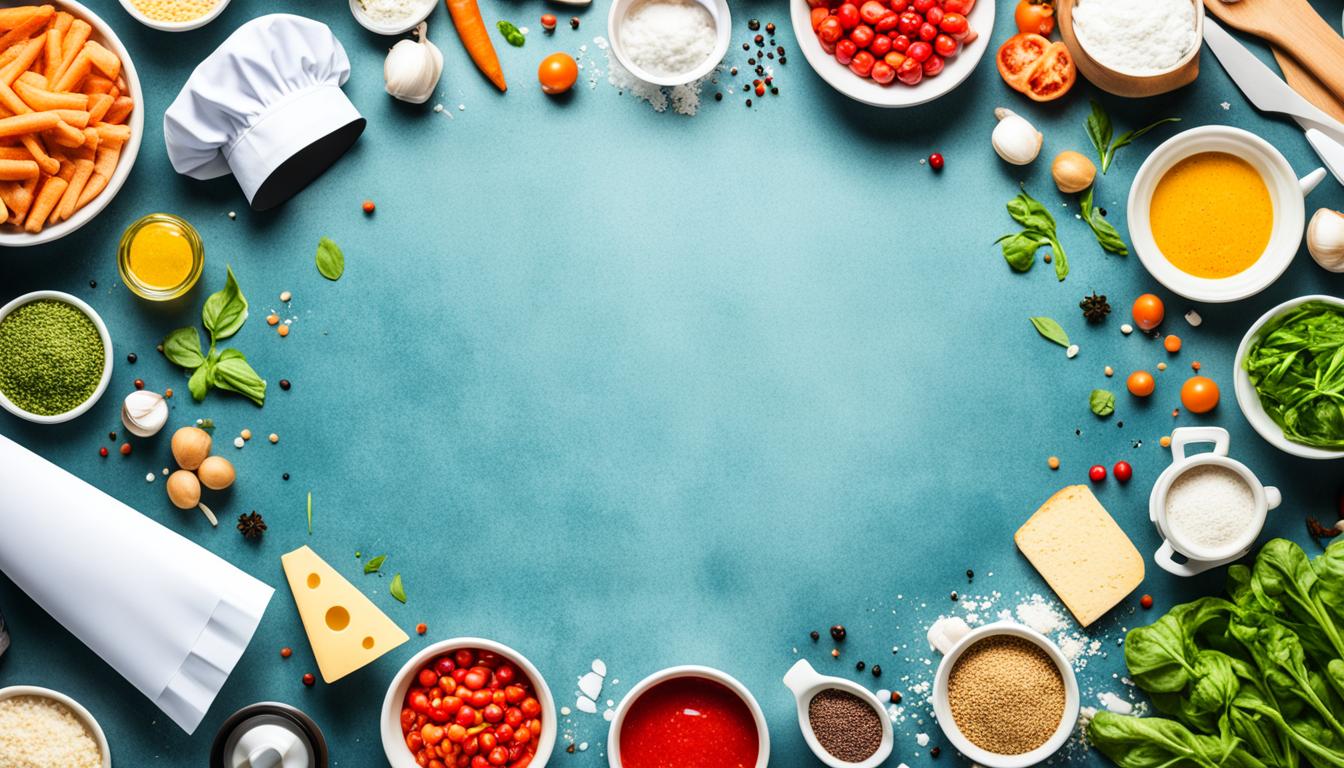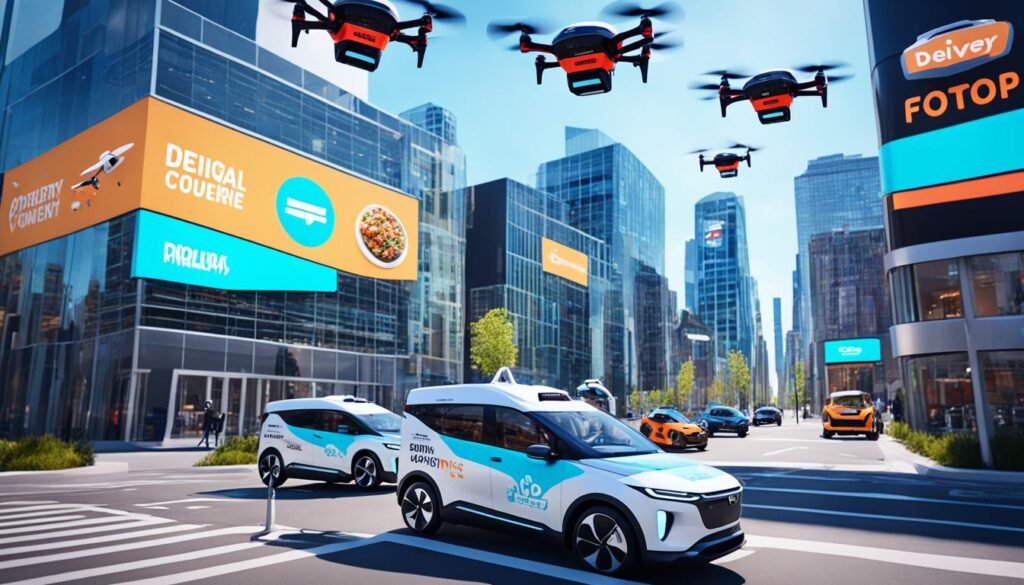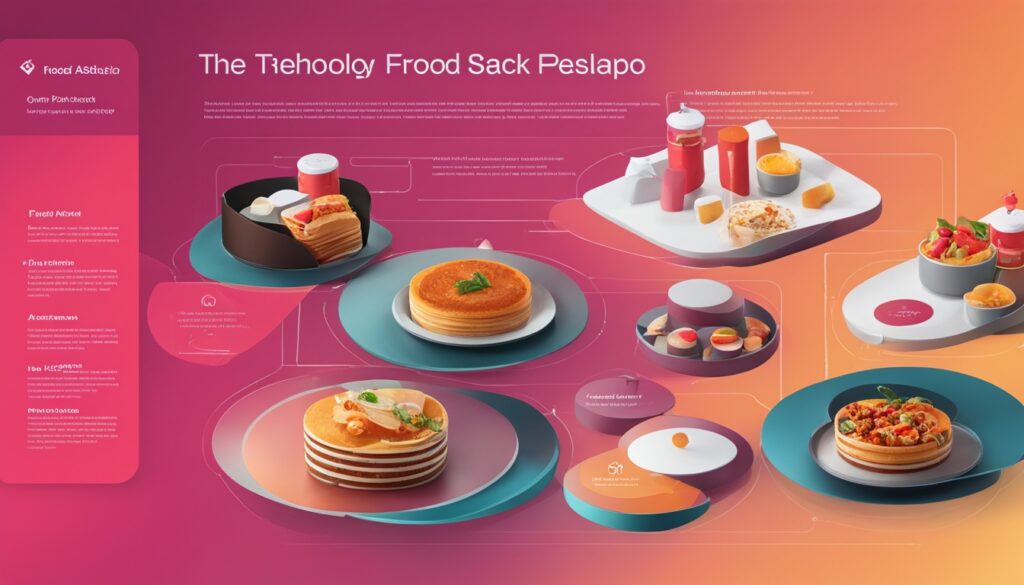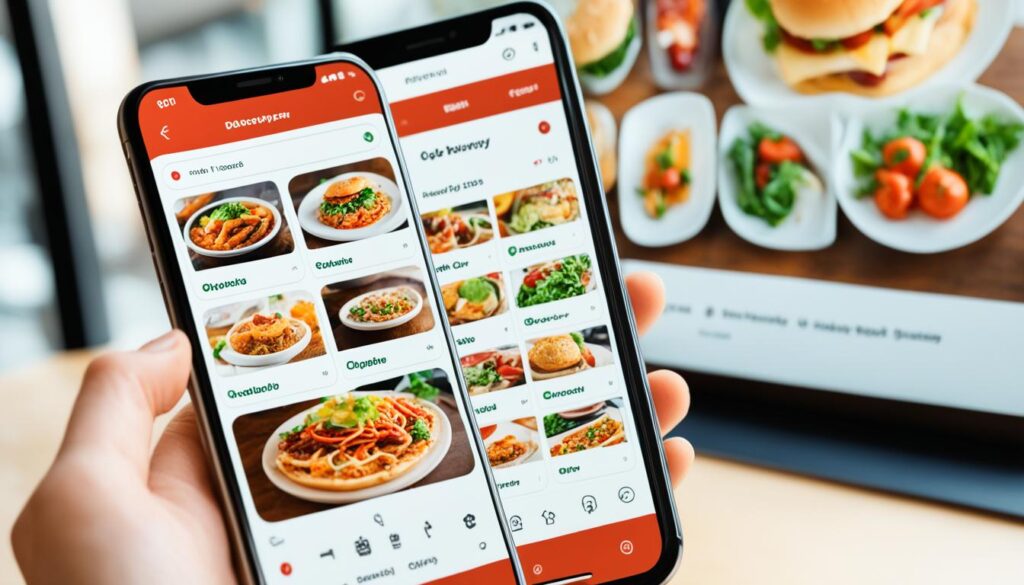The food delivery market has grown a lot in recent years. Platforms like Uber Eats are leading the way. Now, more people want their favorite meals delivered right to their homes. This has made the need for strong and easy-to-use food delivery apps grow even more.
In this guide, we’ll show you how to make a food delivery app as successful as Uber Eats. We’ll cover all the key steps you need to follow.
Table of Contents
Key Takeaways
- Understand the food delivery app market and key industry trends
- Define your target audience and identify key features for your app
- Choose the right technology stack to build a high-performing and scalable food delivery platform
- Focus on delivering a seamless user experience through intuitive app design and integration of delivery and payment gateways
- Implement efficient dispatch systems, geolocation, and real-time tracking features to enhance the overall user experience
Understanding the Food Delivery App Market
The food delivery industry has seen huge growth in recent years. This is thanks to more people wanting on-demand food services. Reports say the global online food delivery market will hit over $200 billion by 2027. This shows how fast the food delivery app market is growing.
Growth and Demand for Food Delivery Services
Food delivery apps have become more popular because they are convenient. People love how easy it is to order food from many restaurants with just a few taps on their phones. This has been especially true during the COVID-19 pandemic when eating out wasn’t allowed.
Also, more people want healthier and varied food options. This has made them turn to food delivery services more often.
Key Players and Industry Trends
Big names like Uber Eats, DoorDash, and GrubHub lead the food delivery app market. They are the top choices for consumers, offering lots of restaurants, tracking your order, and easy payment options. But, new players like Postmates and Caviar are coming up with new features to shake things up.
One big trend is focusing on being more sustainable and eco-friendly. Many food delivery apps are working with restaurants that care about the planet. They’re also trying to reduce their own impact by using less packaging and finding better delivery routes.
| Leading Food Delivery Apps | Market Share (%) |
|---|---|
| Uber Eats | 26.7% |
| DoorDash | 45.6% |
| GrubHub | 13.8% |
| Postmates | 5.9% |
| Caviar | 3.2% |
The food delivery app market is always changing. It’s important for businesses to keep up with new trends and innovations. This way, they can stay competitive and meet what consumers want.
Planning Your Food Delivery App Development
Creating a successful food delivery app starts with knowing your target audience. It’s important to understand who will use your app. Think about their age, where they live, how much they make, and what they like to eat. This helps you make an user profile that guides your app’s design.
Defining Your Target Audience
The people using food delivery apps vary a lot. Some main groups to look at include:
- Busy professionals who love the ease of getting food delivered
- Families wanting a quick way to get meals ready
- Students and young adults who don’t have time or skills to cook
- People focused on eating healthy and finding nutritious food
Knowing who your target audience for food delivery apps is helps you make your app just right for them.
Identifying Key Features and Functionalities
After figuring out who your app is for, focus on what features and functions it should have. Essential features for food delivery apps are things like tracking orders in real-time, easy payment options, and a simple design. Also, must-have functionalities for restaurant delivery apps include filters and search, personalized food suggestions, and rewards programs to make ordering better.
| Feature | Importance | Description |
|---|---|---|
| Real-time order tracking | High | Customers can see where their orders are at all times, making the experience clear and better. |
| Seamless payment options | High | Provides many safe ways to pay, like mobile wallets, cards, and in-app payments, to fit what users like. |
| Intuitive user interface | High | Makes the app easy to use and look good, making ordering food online a better experience. |
| Personalized recommendations | Medium | Uses customer info and likes to suggest foods and places, making users more engaged and happy. |
| Loyalty programs | Medium | Encourages coming back with rewards, discounts, and special deals, building a community feeling. |
Adding these essential features for food delivery apps and must-have functionalities for restaurant delivery apps makes your app complete and focused on users. This approach helps your app stand out in the market segmentation for on-demand food delivery and sets you up for success.
Choosing the Right Technology Stack
Creating a successful food delivery app needs a strong technology stack. This stack must manage order processing, real-time tracking, and work well with other services. When picking a technology stack, think about scalability, security, and how it works with popular technology stack for food delivery apps, programming languages for restaurant delivery software, and tech platforms for on-demand food ordering.
The programming languages you choose affect your app’s performance and upkeep. Here are some top picks:
- Java – A strong and flexible language ideal for building scalable and secure food delivery apps.
- Python – Easy to read and simple, Python is perfect for the backend of your app.
- Node.js – Using JavaScript, Node.js makes real-time communication and data sharing smooth for your app.
Frameworks and libraries also play a big role in making development easier and integrating features smoothly. For instance, React, Angular, and Flutter help create a great user interface. Libraries like Stripe and Braintree make secure payment processing easier.
Choosing the right tech platforms for on-demand food ordering is crucial for your app’s growth and performance. Platforms like Amazon Web Services (AWS), Google Cloud Platform (GCP), and Microsoft Azure provide strong cloud support. This lets you scale your app easily to meet more users and transactions.
“The right technology stack is the foundation for building a scalable and efficient food delivery app that can adapt to the evolving market demands.”
By picking the right technology stack, your food delivery app can handle industry challenges, offer a smooth user experience, and stay competitive.
Designing a User-Friendly Interface
Making a food delivery app look good and easy to use is key to its success. By using top design tips, you can make the app smooth and fun. This will make customers want to use it more and stick with it.
Best Practices for App Design
Here are some top tips for designing a great food delivery app UI:
- Keep the app’s look simple and clean. This makes it easy to use and fun to explore.
- Choose icons, fonts, and colors that match your brand. This makes the app look better and feel more connected to your brand.
- Make sure the app works well on all devices. This means it looks good on phones, tablets, and computers.
- Add features that make the app easy for everyone to use. This includes big fonts, high-contrast modes, and voice commands.
Enhancing User Experience
To make the app a joy to use, try these ideas:
- Make the app suggest food and orders based on what the user likes. This makes the app feel more personal.
- Make ordering easy and smooth. From looking at menus to tracking your order, it should be a breeze.
- Help users find what they need quickly with clear menus, search, and big buttons to click.
- Keep customers updated on their orders. Tell them when their food is on the way and where the driver is.
By following these tips and improving the user experience, you can make your food delivery app stand out. It will attract customers and keep them coming back.
Integrating Delivery and Payment Gateways
For a smooth order and payment process, it’s key to link reliable delivery and payment gateways in your food delivery app. This makes transactions secure and quick, gaining trust and keeping customers coming back. By making food delivery app payment integration and online ordering and payment systems work together, you boost the user experience and help your restaurant delivery business thrive.
Seamless Order and Payment Processing
Creating a smooth order and payment flow is vital for your app. Use top payment processors that offer many payment ways, like credit/debit cards, digital wallets, and mobile payments. Make sure the checkout is secure to protect customers’ financial info and build trust in your app.
Also, link your delivery with the payment gateway for real-time order tracking and updates. This streamlining of order and payment for restaurant delivery makes the user experience better, making customers rely on your app for their food delivery.
| Feature | Benefit |
|---|---|
| Integrated Delivery and Payment Gateways | Streamlined order and payment processing, enhanced user experience, and increased trust in the platform. |
| Secure Checkout Process | Safeguards customer financial information, builds confidence, and encourages repeat business. |
| Real-Time Order Tracking | Provides customers with transparency and a sense of control, improving overall satisfaction. |
By linking delivery and payment gateways well, you make ordering and paying easy and efficient for your customers. This helps your food delivery app succeed.
How to Develop a Food Delivery App Like Uber Eats
Making a food delivery app similar to Uber takes careful planning and a step-by-step approach. The Uber Eats app development process has several key steps. These steps make sure the app works well for users and delivery people.
To build a clone of Uber Eats, start with planning and executing the steps to create a food delivery app. You need to know who your audience is and add cool features like geolocation and real-time tracking. Each part of making the app is important for success and standing out in the market.
- Conduct market research and identify your target audience’s needs and preferences.
- Develop a comprehensive feature set that includes seamless order placement, secure payment gateways, and efficient delivery management.
- Choose the right technology stack to ensure scalability, performance, and compatibility across multiple platforms.
- Design a visually appealing and intuitive user interface that enhances the overall user experience.
- Integrate robust delivery and mapping features to provide customers with real-time order tracking and dispatch optimization.
- Implement robust data security and privacy measures to protect user information and comply with industry regulations.
- Conduct thorough testing and quality assurance to identify and address any issues before deployment.
- Develop effective marketing and promotion strategies to drive user acquisition and engagement.
| Key Considerations | Description |
|---|---|
| Scalability | Ensure your app can handle increasing user demand and transaction volumes without compromising performance. |
| Delivery Optimization | Implement efficient algorithms to optimize delivery routes and minimize delivery times. |
| User Experience | Prioritize a seamless and intuitive user experience to drive customer satisfaction and loyalty. |
| Data Security | Implement robust security measures to protect user data and comply with industry regulations. |
“Developing a food delivery app like Uber Eats requires meticulous planning, cutting-edge technology, and a deep understanding of user needs. By following a well-defined roadmap, you can create a platform that delivers delightful experiences and sets you apart in the competitive food delivery market.”
Implementing Geolocation and Mapping Features
In today’s fast-paced world, making your food delivery app easy to use is key to success. Adding food delivery app geolocation features is a great way to improve the experience. These features let customers and drivers track orders in real-time.
Real-Time Tracking for Customers and Drivers
Using GPS and mapping tech, your app can let customers track their orders as they move. This keeps them updated and helps them plan their day. For drivers, it means they can find the best routes, making sure food arrives on time.
GPS helps your app give accurate location info, making it simple for customers to find restaurants and track their food. This boosts the user experience and makes your delivery service more efficient.
“Geolocation and mapping features are essential for modern food delivery apps, as they enable seamless tracking and efficient delivery, ultimately improving customer satisfaction.”
Adding these geolocation and mapping tools to your app makes it a full-featured platform. It meets the needs of customers and drivers, leading to more loyal customers and growth for your business.
Building an Efficient Dispatch System
Creating a strong dispatch system is key for food delivery apps. It helps manage orders better and makes delivering food faster and more reliable. This makes customers happier.
To make a great dispatch system, app developers should pay attention to a few important things:
- Order Assignment and Allocation: Use smart algorithms to quickly give orders to the best drivers. Look at location, how busy they are, and how fast they can deliver. This makes sure orders go to the nearest and quickest drivers.
- Real-Time Tracking and Monitoring: Add GPS and maps for tracking drivers in real-time. This lets the dispatch team see where orders are and make smart choices to improve delivery times.
- Automated Dispatching: Use AI to make dispatching orders automatic. Change driver assignments and routes based on traffic, weather, and what customers want.
- Optimization and Scalability: Make the dispatch system grow and change with more orders and customer needs. It should stay efficient and work well, no matter how busy it gets.
By focusing on these areas, food delivery apps can make their work flow better. They can manage orders well and give a great experience to customers and drivers.
| Feature | Benefit |
|---|---|
| Automated Order Assignment | Orders go to the closest and most ready drivers. This cuts down on wait times and makes customers happier. |
| Real-Time Tracking and Monitoring | The dispatch team can watch orders move along, make quick changes, and tell customers when to expect their food. |
| Scalable Algorithms | The system can handle more orders and change with the market without losing speed or efficiency. |
“An efficient dispatch system is the backbone of a successful food delivery app, ensuring seamless order management and reliable logistics for on-demand food ordering.”
With a well-made dispatch system, food delivery apps can manage orders better, give customers a great experience, and grow in the competitive food delivery market.
Ensuring Data Security and Privacy
In the fast-paced world of food delivery apps, keeping customer and business data safe is crucial. Users share their personal info with these apps, so developers must protect it well. They need to use strong security steps to keep data safe from hackers and other threats.
Compliance with Industry Regulations
Food delivery app makers must keep up with data privacy laws like GDPR and PCI DSS. Following these rules makes sure customer info, like payment and personal details, is used right. Doing regular security checks and following best practices helps apps meet these standards and avoid fines.
To boost data security, food delivery apps should use strong encryption, secure login, and safe payment gateways. Also, good API security and privacy settings protect against unauthorized access and data theft. Having plans for security checks and how to handle incidents is key to being ready for any security issues.
“Maintaining the trust of our customers is paramount. We prioritize data security and privacy in every aspect of our food delivery app development to ensure the protection of sensitive information.”
By focusing on data security and privacy, food delivery app developers can meet industry rules and keep their customers’ trust. This approach sets them apart in a crowded market and helps them succeed over time.
Testing and Quality Assurance
Creating a strong food delivery app needs a detailed testing and quality check process. Using both automated and manual testing helps make sure your app works well, stays stable, and gives a great user experience.
Automated Testing for Food Delivery Apps
Automated testing is key for food delivery apps. Using unit tests, integration tests, and end-to-end tests can spot and fix problems early. It saves time and resources, keeps the code quality high, and makes sure the app works right even after updates.
Manual Testing for On-Demand Food Ordering
Even though automated testing is vital, manual testing is also crucial for food delivery app testing strategies. It checks the app’s look, how easy it is to use, and the overall experience. Getting real users to test the app helps find issues that automated tests might miss.
| Testing Approach | Benefits | Challenges |
|---|---|---|
| Automated Testing |
|
|
| Manual Testing |
|
|
Using a mix of automated and manual testing makes sure your quality assurance for restaurant delivery software is top-notch. This approach helps find and fix problems before the app launches. It’s key to making your food delivery app a success.
App Deployment and Launch Strategies
Launching a successful food delivery app needs a solid plan. This means making your app stand out on app stores with App Store Optimization (ASO). It also means using targeted marketing and always checking and improving the app.
App Store Optimization (ASO) for On-Demand Food Ordering
To make your food delivery app noticeable, you must make it easy to find. App Store Optimization (ASO) is key to getting your app noticed. It helps your app rank higher and draw in users by making it easy to search for and look at.
- Do deep keyword research to find the best keywords for your app.
- Write a catchy title and description that show off what makes your app special.
- Make your app’s visuals appealing and easy to use.
- Get good reviews and ratings to boost your app’s ranking and trustworthiness.
Good ASO makes your app more visible and attracts more users. This leads to more downloads and a successful food delivery app deployment.
Strategies for Launching a Restaurant Delivery App
Along with ASO, you need a strong marketing plan for your app. This could include:
- Using social media to spread the word and connect with people.
- Working with local restaurants to promote your app together.
- Offering deals like discounts to get people to sign up and tell others.
- Listening to user feedback and making your app better based on it.
By using ASO and smart marketing, you can launch your app well and keep it growing. This follows the best ways to food delivery app deployment.
Marketing and Promotion Tactics
For a food delivery app to succeed, you need a strong marketing plan. Use social media, influencer marketing, and targeted ads to reach your audience. This helps build brand awareness and keeps users coming back to your app.
Having a strong social media presence is key. Use Facebook, Instagram, and Twitter to connect with customers and show off your brand. Share interesting content, run special campaigns, and work with influencers to reach more people and keep them loyal.
Working with influencers is another great way to promote your app. Partner with popular social media stars or experts to reach their followers. This can help build trust and get more people to use your app.
Also, use ads on Google, Facebook, or local campaigns to get your app noticed. Make sure your ads are well-made to get a good return on your investment. This way, you’ll attract the right users to your app.
| Marketing Channel | Key Strategies | Potential Benefits |
|---|---|---|
| Social Media |
|
|
| Paid Advertising |
|
|
| Influencer Marketing |
|
|
“Effective marketing and promotion are essential for the success of any food delivery app. By adopting a strategic and multi-faceted approach, you can reach and engage your target audience, build brand loyalty, and drive sustainable growth for your business.”
Conclusion
Creating a food delivery app like Uber Eats needs a strategic plan. It’s important to know the market and who you want to reach. You also need to make your app easy to use and have good delivery and payment systems.
When making an app like Uber Eats, use the latest tech like geolocation and real-time tracking. This makes the customer’s experience better. Also, having a good dispatch system and keeping data safe and private is key to standing out.
The future of food delivery will change with new tech and what customers want. To stay ahead, you need to be quick to adapt and keep improving your app. By doing this, you can make your Uber Eats-like app successful and take advantage of the growing demand for easy food delivery.













